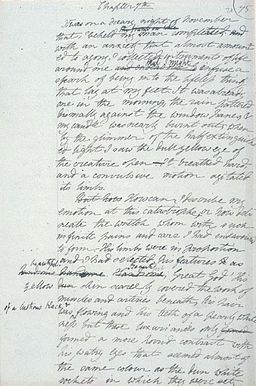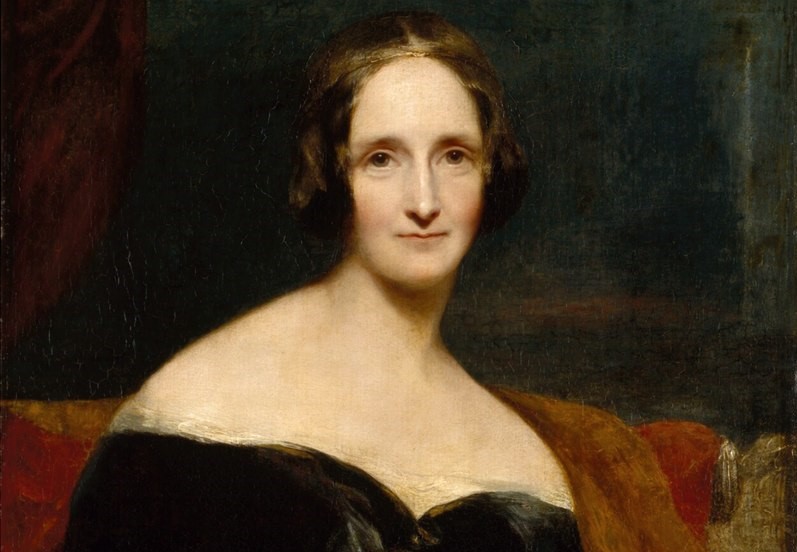It would be difficult to feel anything other than admiration and sympathy for Mary Shelley, as she faced a series of cruel blows during her childhood and early adulthood.
In 1814 Shelley left his pregnant wife to elope with Mary, who was also expecting a baby.She was born Mary Wollstonecraft Godwin, in London in 1797, to the radical feminist Mary Wollstonecraft and the philosopher William Godwin. Her mother died soon afterwards; her father found another partner, and young Mary was brought up with stepsiblings and with Wollstonecraft’s daughter, Fanny Imlay. She read voraciously, learned five languages, and was used to meeting her father’s literary friends, including William Hazlitt, Charles Lamb and Coleridge.
In 1807 the family moved to Holborn, where Mary could hear the screams of animals being slaughtered in the candlelit abattoirs under Smithfield. As she suffered from poor health, she was sent away for long periods to recuperate. During one memorable journey she hid her money carefully in her stays for safety; nevertheless it was stolen from her! From the age of thirteen she had terrible eczema, possibly triggered by her poor relationship with her stepmother.
The poet Percy Shelley was already married when he became involved with Mary. They began to meet secretly by Wollstonecraft’s grave. In 1814 Shelley left his pregnant wife to elope with Mary, who was also expecting a baby. They took with them her stepsister, Jane (later Claire) Clairmont, and this scandalous triangular relationship lasted for eight years as they moved between England, France, Germany, Italy and Switzerland. Mary’s first published work, the co-authored text History of a Six Weeks Tour (published 1817), described some of their travels.
 Manuscript page from Frankenstein by Mary Shelley, 1816.
In February 1815 Mary gave birth to Clara, who lived for only twelve days. Her journal shows that she was haunted by the sense that the death might have been prevented. A son, William, was born in January 1816, and Shelley took Mary, Claire and the baby to Geneva. Here, Byron proposed that they should write ghost stories. Mary’s effort, Frankenstein, was penned at a time when scientists were investigating the possibility of using electrical power to regenerate corpses. Her novel concerned Victor Frankenstein’s attempt to re-animate a dead body, and the dreadful consequences of his actions.
Manuscript page from Frankenstein by Mary Shelley, 1816.
In February 1815 Mary gave birth to Clara, who lived for only twelve days. Her journal shows that she was haunted by the sense that the death might have been prevented. A son, William, was born in January 1816, and Shelley took Mary, Claire and the baby to Geneva. Here, Byron proposed that they should write ghost stories. Mary’s effort, Frankenstein, was penned at a time when scientists were investigating the possibility of using electrical power to regenerate corpses. Her novel concerned Victor Frankenstein’s attempt to re-animate a dead body, and the dreadful consequences of his actions.
Her own life was fast becoming a nightmare: Fanny Imlay committed suicide; Shelley’s wife drowned herself in the Serpentine; Mary and Shelley married and had a third baby, another Clara, in 1817, but she died the following year. Their grief was compounded when their precious William died of malaria in 1819. In his jotting book Percy wrote:
My dearest M. wherefore hast thou gone
And left me in this dreary world alone,
Thy form is here indeed – a lovely one –
But thou art fled, gone down the dreary road,
That leads to Sorrow’s most obscure abode
For thine own sake I cannot follow thee
Do thou return for mine.
Thankfully their fourth child survived into adulthood: he was called Percy Florence – no prizes for guessing where he was born!
Percy Shelley drowned in 1822, following a visit to Byron and Leigh Hunt. His body was cremated, with onlookers trying to snatch keepsakes from the flames. Byron wanted the skull, but it disintegrated. Mary salvaged what was left of Shelley’s heart: after her own death it was discovered, wrapped in silk, between the pages of Adonis, having lain for almost thirty years in her travelling-desk. In her journal Mary sometimes addressed Shelley: ‘What were I if I did not believe that you still existed?’ (October 1822); and in November she wrote: ‘So may it be said of me that I am nothing, but I was something and still I cling to what I was.’
In her novel the scientist who re-animates the corpse is called Frankenstein; yet ironically by 1830 his creation was being referred to by this name.Returning to London in 1823 Mary found that Frankenstein had become a stage production, complete with a frightening monster which sprang from a concealed laboratory at the top of a staircase! In her novel the scientist who re-animates the corpse is called Frankenstein; yet ironically by 1830 his creation was being referred to by this name. Mary’s original creature is not evil; he is an innocent victim, who develops and yearns to be integrated into society. He becomes malign after being rejected by his creator and by society, declaring: ‘I am malicious because I am miserable.’ Nevertheless the word ‘Frankenstein’ gradually became associated with things that were monstrous and threatening.
Mary’s financial situation was precarious, so she continued to write. Valperga (1823) is a historical romance about fourteenth century Italy. The Last Man (1826) is a novel set in the future, in which the human race is being destroyed by plague. Perkin Warbeck came out in 1830, and the semi-autobiographical Lodore and Falkner in 1835 and 1837 respectively. From 1824-40 Mary also produced articles for journals, tales for literary annuals and five volumes of literary biography.
Fortunately her last years were relatively contented ones, because Percy was a fine and affectionate son, and his wife, Jane, thought the world of her.She needed to rehabilitate herself in society, for young Percy’s sake. Her correspondence and journals of the 1830s show her attending the opera and Royal Ascot. Percy was sent to Harrow, before going to Cambridge. Mary seemed unaware that the boys at Harrow spent their time beagling, boozing and ‘toozling’ (stoning birds)
In 1833 she anticipated a marriage proposal from a man called Aubrey Beauclerk; however he married someone else. Later, when he was a widower, she again hoped for happiness with him; but this, too, came to nothing. Fortunately her last years were relatively contented ones, because Percy was a fine and affectionate son, and his wife, Jane, thought the world of her. After Mary’s death in 1851, Jane commissioned a monument, modelled after Michelangelo’s Pièta, and created a ‘shrine’ for Mary, Shelley and their circle at Boscombe Lodge, near Bournemouth.
To get to grips with Mary Shelley, it is worth looking at her journals, letters and fiction together. They reveal a remarkable woman, who overcame tragic circumstances. She also gave us Frankenstein - an amazing, complex work that defies classification. Rewriting the ancient Greek myth of Prometheus, and linking her ideas to Milton’s Paradise Lost and to Genesis, Mary Shelley successfully blended realist, Gothic and Romantic elements to produce an influential and enduring literary masterpiece.




Rate and Review
Rate this article
Review this article
Log into OpenLearn to leave reviews and join in the conversation.
Article reviews